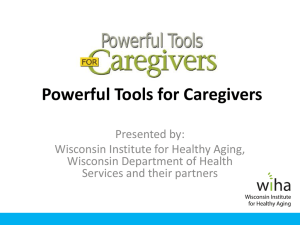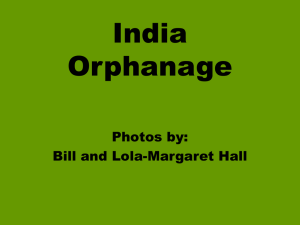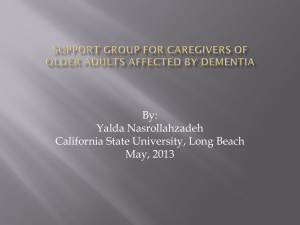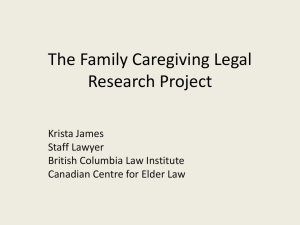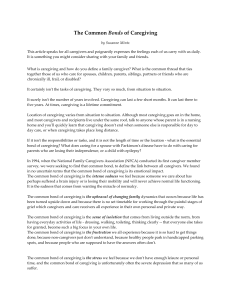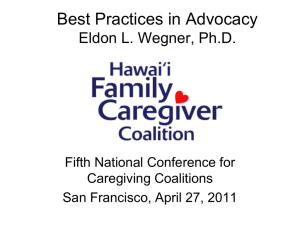Intervention and Evaluation Supplements (PowerPoint)
advertisement
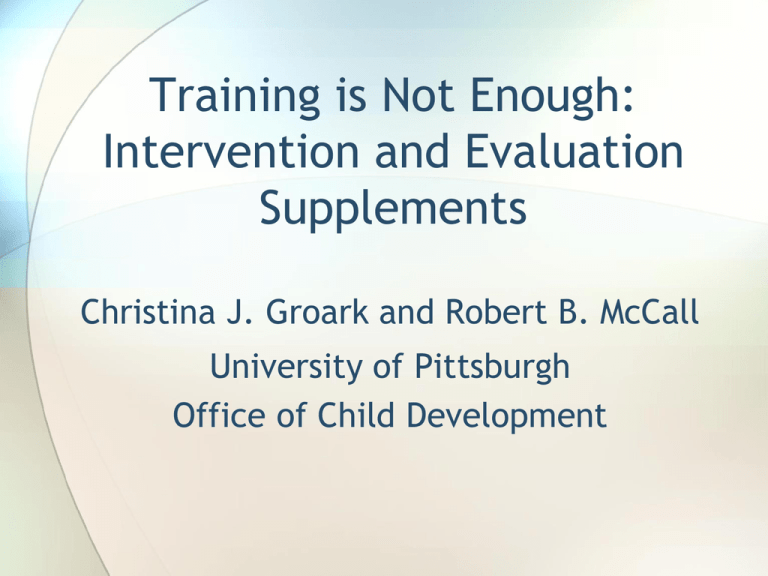
Training is Not Enough: Intervention and Evaluation Supplements Christina J. Groark and Robert B. McCall University of Pittsburgh Office of Child Development Overview—Intervention • Training alone is a minimally effective intervention • Need: − Hands-on technical assistance in situ − Supportive work environment − Continuous monitoring, positive supervision Overview—Evaluation • Assessing trainee’s satisfaction and learning is a minimum evaluation • Need: − Changes in trainee’s on-the-job behavior − Changes in the behavior/outcomes of clients of the trainees − Analyses to show trainees behavior change mediated the intervention's effect on clients’ behavior/outcomes Intervention Training alone is minimally effective Why? Trainees often do not change their behavior Need: • On-the-ground technical assistance • Supportive work environment • Monitoring and positive supervision Intervention On-the-ground technical assistance • Observe (videotape) client on job • Constructive, positive feedback • Modeling with client on job • Daily review Intervention Intervention Work environment • Supports behaviors taught in training • Hand washing—need a sink, waterless soap handy • Early care and education—need small group size, low children:caregiver ratio, a few consistent caregivers Chaotic Child Environment Orderly Child Environment 9 Monitoring and positive supervision • Sets expectations, standards, reminds, rewards • Continuing system, supervisor, staff meetings • Hand washing • Early care and education—teachable moments, responsiveness to childdirected initiatives Illustrative Example I Latin American Orphanage Intervention (birth-6 years) • Training—sensitive, responsive interactions ◦ 6 one-day training sessions • On-the-ground technical assistance ◦ 12 days more than planned because caregivers were not implementing BUT – • Limited environmental change ◦ 4 primary caregivers per ward ◦ 8-10 children per caregiver • No continuing supervision Results—Caregiving behavior/environment (ITERS/ECERS) 7 Mean Total ITERS/ECERS 6 5 Typical USA Early Care 4 3 2 1 Pre- Post- Intervention Results—Children’s development (Battelle) 100 Typical Parent-Reared Battelle 90 80 70 60 Post- Pre- Intervention Conclusion • Needed hands-on technical assistance to promote implementation • Limited supportive work environment • No supervisory system • Some improvement in caregivers, children, but NOT MUCH Illustrative Example II St. Petersburg (Russia) Orphanage Intervention • More intensive, comprehensive • All major components • Minimum warm, sensitive, contingentlyresponsive caregiver-child interactions • Perfunctory, business-like; little talking • Caregiver directed • Conformity St. Petersburg-USA Orphanage Research Team, 2005, 2008 4/13/2015 18 • 12-14 children/ward • 9-12 caregivers/week • Homogeneous age, disability groups • Periodic graduations • 60-100 caregivers before age 19 months St. Petersburg-USA Orphanage Research Team, 2005, 2008 4/13/2015 20 Intervention • Training ◦ Train Trainers ◦ 12 sessions, 2-3 hrs. ◦ Warm, sensitive, responsive ◦ “Love these kids…” • Hands-on technical assistance Intervention—Supportive Work Environment • Reduced group size to 6-7 • Assigned primary, secondary caregivers—6 vs 9 cgrs. • Changed work schedules • Integrated groups by age, disabilities • Eliminated periodic graduations to new groups • Family hour Intervention—Monitoring and Positive Supervision • Training for supervisors • Trainer observed, coached both caregivers and supervisors • Supervisors met periodically to problem solve, case reviews, mutual support Evaluation Three orphanages (Baby Homes), birth – 4 years • T+SC/M&S—Training plus Structural Changes, Monitoring, Supervision • TO—Training Only • NoI—No Intervention Evaluation—Trainee Learning Evaluation—Improved Caregiving Longitudinal Sample T+SC Evaluation – Children’s Development 100 Typical Parent Reared Developmental Quotient 90 T+SC 80 TO 70 NoI 60 50 40 First 4-9 mos Time in Intervention 9+ mos Evaluation--Mediation Analysis • Intervention improved caregiving • Intervention improved children’s development • But was children’s developmental improvement associated with improved caregiving? Evaluation—Mediation Analysis Two-Stage Theory of Change: T= Train Caregivers SC=Structural Changes T+SC vs NoI Better Caregiving Environment HOME Better Children’s Development Battelle DQ Evaluation--Mediation Analysis Independent Variable T+SC vs NoI Intervention Effect of Indep. Var. on Mediator a = 3.41(.22)*** Independent Variable T+SC vs NoI Intervention Total Effect Ĉ = 14.14(2.07)*** Mediator HOME Direct effect Controlling for Mediator Ĉ = 8.00(2.87)*** Outcome Battelle Effect of Mediator on Outcome Controlling for Indep. Variable b = 1.80 (.59)** Outcome Battelle Mediator accounts for 43% of Total Effect Conclusion • Intervention ◦Training alone is often minimally effective ◦Has greater effect if accompanied by On-the-ground technical assistance Supportive work environment Monitoring and supervision Conclusion • Evaluation is improved if ◦ Some training vs. No Training comparison ◦ Measures of – Learning – Work-place behavior change – Outcome behavior of clients ◦ Mediation analysis Evaluation Mediation Analysis: MacKinnon, D. P., & Dwyer, J. H. (1993). Estimating mediated effects in prevention studies. Evaluation Review, 17(2), 144-158.

